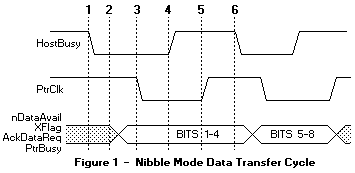| SPP Signal | Nibble Mode Name |
In/Out | Description Signal usage when in Nibble Mode data transfer |
|---|---|---|---|
| nSTROBE | nSTROBE | Out | Not used for reverse data transfer |
| nAUTOFEED | HostBusy | Out | Host nibble mode handshake signal. Set low to indicate host is ready for nibble. Set high to indicate nibble has been received. |
| nSELECTIN | 1284Active | Out | Set high when host is in a 1284 transfer mode. |
| nINIT | nINIT | Out | Not used for reverse data transfer |
| nACK | PtrClk | In | Set low to indicate valid nibble data, set high in response to HostBusy going high. |
| BUSY | PtrBusy | In | Used for Data bit 3, then 7 |
| PE | AckDataReq | In | Used for Data bit 2, then 6 |
| SELECT | Xflag | In | Used for Data bit 1, then 5 |
| nERROR | nDataAvail | In | Used for Data bit 0, then 4 |
| DATA[8:1] | Not Used | - | - |

1284 Nibble Mode phase transistion
- Host signals ability to take data by asserting HostBusy low
- Peripheral responds by placing first nibble on status lines
- Peripheral signals valid nibble by asserting PtrClk low
- Host sets HostBusy high to indicate that it has received the nibble and is not yet ready for another nibble.
- Peripheral sets PtrClk high to acknowledge host
- States 1 through 5 repeat for the second nibble
Nibble mode, like the Compatible mode, requires that the software drive the
protocol by setting and reading the lines on the parallel port. Nibble mode is the most
software intensive mode for reverse channel data communication. For this reason, there is
a severe limitation of approximately 50K bytes per second for this type of data transfer.
The major advantage of this combination of modes is the ability to operate on all PCs that
have a parallel port. The performance limitations incurred by the Nibble mode operation
does not have much visible effect on peripherals that have low reverse channel
requirements, such as printers, but can be nearly intolerable when used for LAN adapters,
disk drives or CD ROM drives.
Back to
Please see the LEGAL - Trademark notice.
Feel free - send a  for any BUG on this page found - Thank you.
for any BUG on this page found - Thank you.